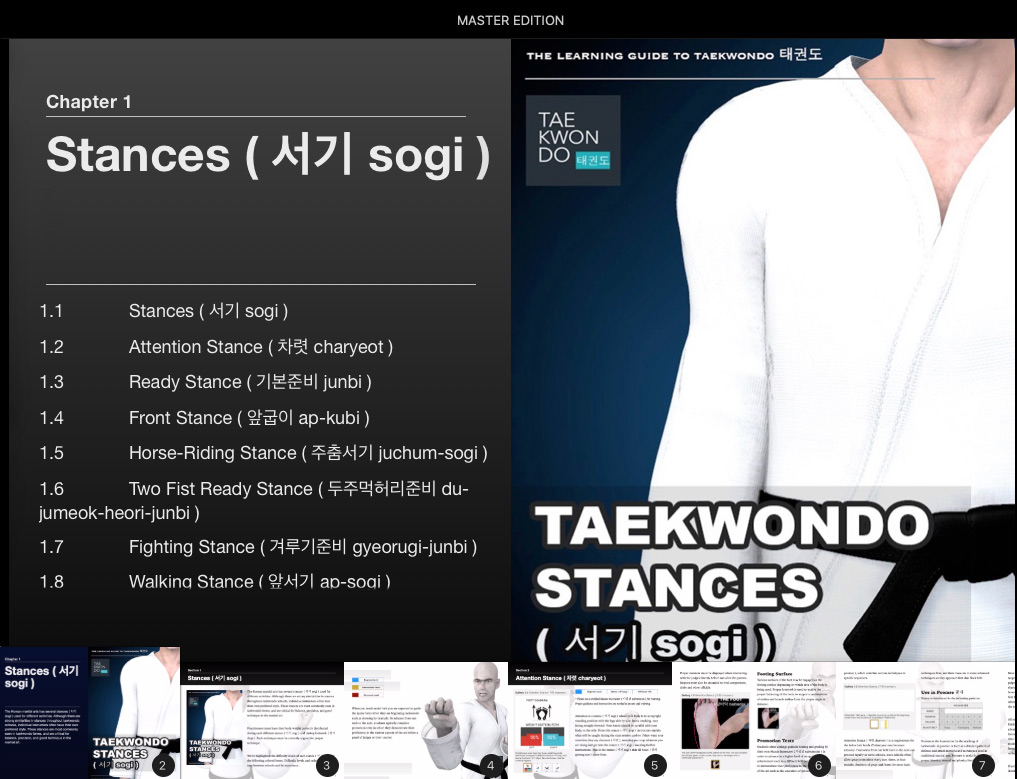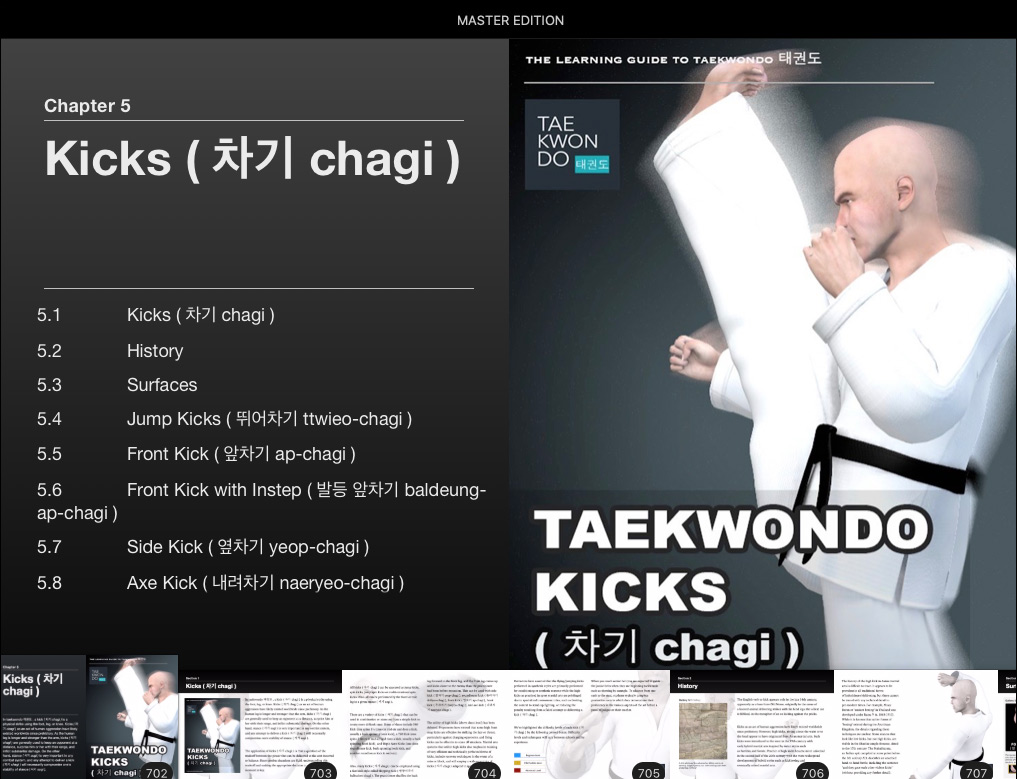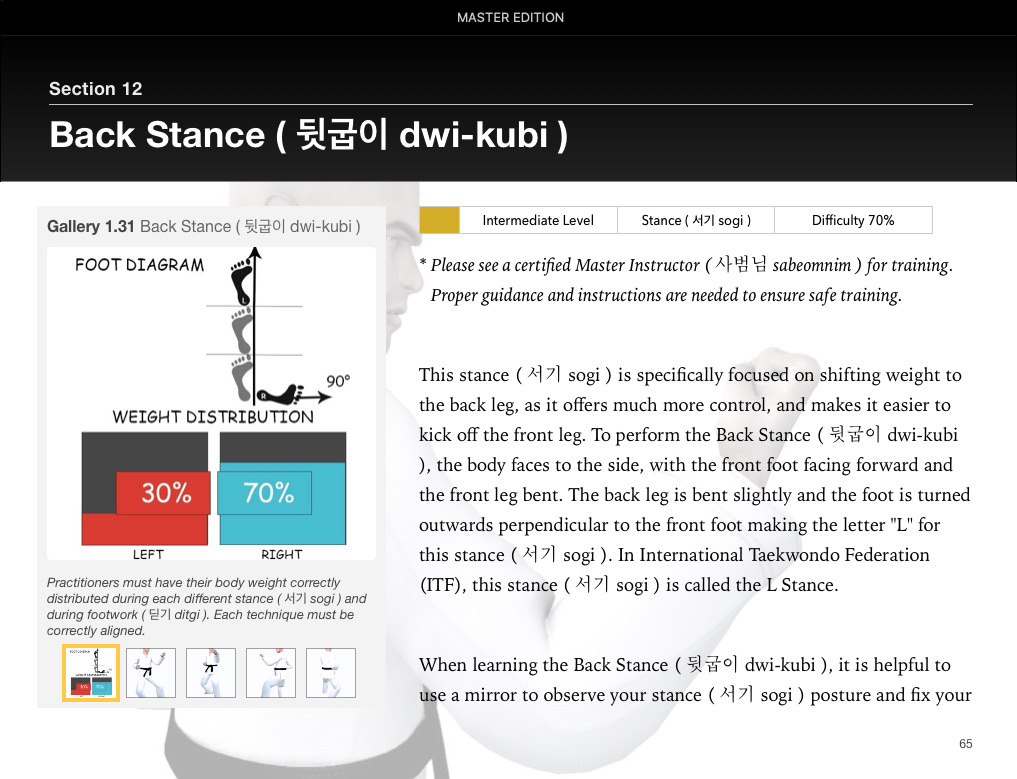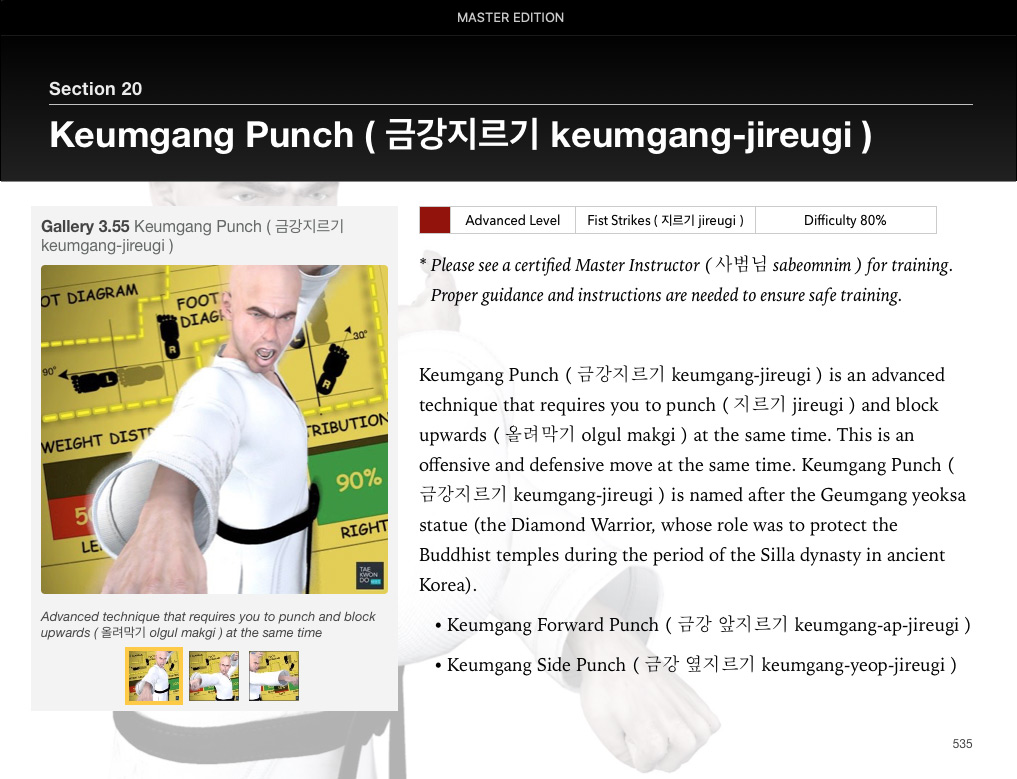Taekwondo 태권도Taekwondo Preschool
Promotion from one geup to the next can proceed rapidly in some schools, since schools often allow geup promotions every two, three, or four months. Students of geup rank learn the most basic techniques first, and then move on to more advanced techniques as they approach first dan. Many of the older and more traditional schools often take longer to allow students to test for higher ranks than newer, more contemporary schools, as they may not have the required testing intervals. View Taekwondo belt levels »
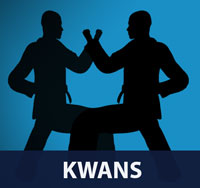
Original Taekwondo Kwans 관
In Korean literally means building or hall, but when used in martial arts it can also refer to a school or clan of martial artists who follow the same style and/or leader.
The Five Original Taekwondo Kwans
Song Moo Kwan
Founded March 11, 1944 by Ro, Byung Jick, who had studied Shotokan (Song Do Kwan) karate along with Chung Do Kwan founder Lee, Won Kyuk under Gichin Funakoshi in Japan. In the 1960s Ro's son and eventual successor, Ro Hee Sang began studying Hapkido in 1963 and Northern Shaolin Kung Fu in 1967. He (Ro, Hee Sang) subsequently became an instructor to the Korean Army and one of Korea's Taekwondo champions. He trained Karate, Hapkido, Kumdo and Northern Shaolin Kung Fu. View Song Moo Kwan »
Chung Do Kwan
Founded in 1944 by Lee, Won Kyuk. He had studied Taekkyon in An Gup Dong (Seoul), He also studied Karate in Okinawa, Kung Fu centers in Henan and Shanghai in China, and other. After liberation of Korea, the Chung Do Kwan had risen to become 2nd biggest Taekwondo organization in Korea. View Chung Do Kwan »
Moo Duk Kwan
Founded after 1946 by Hwang Kee. Kee studied Taekkyon, T'ai chi and some types of Kung Fu with Yang Kuk Jin in China. Kee claims he learned the philosophy of Okinawan Karate from Gichin Funakoshi's books. His first two attempts at running a school of Hwa Soo Do were unsuccessful. He then trained with Won Kyuk Lee at the Chung Do Kwan, gaining the equivalent of a green belt. Lee claims Kee was his student, but Kee disputes Lee's claim, and acknowledges only Yang Kuk Jin as his teacher. In 1957, Kee made a discovery of Soo Bahk, a true Korean martial art, from Muye Dobo Tongji. Kee developed the Soo Bahk system to be studied through the Moo Duk Kwan. He chose the name Soo Bahk Do, a derivative of Soo Bahk Ki, hand striking technique, and Soo Bahk Hee, hand striking dance, which were detailed in the Muye Dobo Tongji. In 1960, the Korean Soo Bahk Do Association was incorporated and officially registered with the Korean government as the traditional Korean martial art. The following year, the Moo Duk Kwan discipline was recognized internationally for the first time. By 1953 and onward until 1960, the Moo Duk Kwan had risen to become biggest Moo Do organization in Korea, with close to 75% of all martial artists in Korea practicing Tang Soo Do Moo Duk Kwan. View Moo Duk Kwan »
Chang Moo Kwan

Founded in 1946 by Yoon, Byung-In, who had studied Chinese Kung Fu (ch'uan-fa) under the guidance of a Mongolian instructor in Manchuria. Later, Yoon trained karate at university karate club in Japan with Kanken Tōyama. When he trained Karate in Japan, Japanese karate students pursued the Korean student and beat them up. Yoon Byung-in angered from the Japanese karate students, Yoon Byung-in sprung into action using Chuan-fa. He skillfully deflected and evaded the karate students’ strikes and kicks to the point that they gave up and ran back to tell their teacher about what happened. Teacher Kanken Tōyama invited Yoon Byung-in to tell him about the skillful non-karate martial art he used against his students. Yoon Byung-in explained to Toyama about his Chuan-fa education in Manchuria. Toyama appreciated the Chuan-fa background since he (Toyama) had studied Chuan-fa in Taiwan for 7 years, previously. They decided to exchange knowledge; Yoon Byung-in would teach Toyama Kanken Chuan-fa and Toyama Kanken would teach Yoon Byung-in his Shudo-Ryu karate. Yoon later created his art and called as Kwon Bop Kong Soo Do. Unlike other taekwondo kwans, early Chang Moo Kwan was mainly based on Chinese Kung Fu (ch'uan-fa). The early Chang Moo Kwan taught Palgi kwon (which influenced by Bājíquán). Yoon went missing during the Korean War. His teachings were carried on by his top student Lee Nam Suk, who changed the name of the school to Chang Moo Kwan. 10th Dan Grandmaster Soon Bae Kim is currently the President of Song Moo Kwan and is one of two Kukkiwon 10th Dans in charge of Kukkiwon testing. View Chang Moo Kwan »
Jidokwan
Founded March 3, 1946 by Chun, Sang Sup, who had studied Shotokan karate with Gichin Funakoshi in Japan, and later called his art Kong Soo Do. he had a very close relationship with Yoon, Byung-In, founder of Kwon Bop Bu. Chun and Yoon would travel to train with other martial artists, sometimes traveling to Manchuria. They trained with each other so much that they became known as brothers. The full name of this kwan was "Chosun Yun Moo Kwan Kong Soo Do Bu" (the Chosun Yun Moo Kwan had been the original Japanese Judo school in Korea for over 30 years previously). Chun went missing during the Korean War; subsequently, this kwan voted to change its name to Jidokwan. After Chun disappeared in Korean War, the original students of Chun voted Master Yon who Trained in Chuan Fa in Manchuria as Jidokwan 1st President. View Jidokwan »
Later important Taekwondo kwans (post Korean War)
- Han Moo Kwan » Founded in August 1954 by Lee Kyo Yoon as an offshoot of the Yun Moo Kwan/Jidokwan.
- Oh Do Kwan » Founded in 1955 by Choi Hong Hi, Nam Tae Hi, and Han Cha Kyo as an offshoot of the Chung Do Kwan.
- Kang Duk Won » Founded in 1956 by Park Chul Hee and Hong Jong Pyo as an offshoot of the Kwon Bop Bu/Chang Moo Kwan.
- Jung Do Kwan » Founded in 1956 by Lee Yong Woo (died August, 2006) as an offshoot of the Chung Do Kwan.
The four later Kwans are considered annex kwans, since they all are lines from one of the 5 earlier kwans.

Training Safety Precautions
Starting with coloured belts taekwondo students must learn Breaking ( 격파 gyeokpa ). As they progress through the ranks, the breaks they perform increase in difficulty as do the number of boards. Wooden boards are the most common breaking item in most martial arts.
There are safety concerns with taekwondo breaking ( 격파 gyeokpa ), so one should seek out a certified Master Instructor ( 사범님 sabeomnim ). There are many small bones of the foot ( 발 bal ) and hand ( 손 son ) which need to be very carefully and slowly conditioned for safety. Repeated damage to the extensor capsules of the knuckles can lead to long term problems with dexterity. View Breaking ( 격파 gyeokpa ) »
* Please see a certified Master Instructor ( 사범님 sabeomnim ) for training. Proper guidance and instructions are needed to ensure safe training.

Original Taekwondo Kwans ( 관 )
In Korean, kwan ( 관 ) literally means building or hall, but when used in martial arts it can also refer to a school or clan of martial artists who follow the same style and/or leader. On January 8, 1977, nine of the largest kwans unified, recognizing the Kukkiwon 국기원 as being the black belt promotional body for taekwondo. Prior to this declaration, many practitioners had considered their individual kwan certifications as being more valuable than the certificates which were issued by the Kukkiwon 국기원 or Korea Taekwondo Association (KTA). For more information View Taekwondo Kwans ( 관 ) »
There are five tenets defined in the International Taekwondo Federation (ITF) and several more in World Taekwondo (WT).
Courtesy ( 예의 ye-ui ): "Showing courtesy to all, respecting others, having manners as well as maintaining the appropriate etiquette at all times, both within and outside the dojang (도장) (designated training area)." View Taekwondo Tenets »
RESOURCES
This article uses material from the Wikipedia article "Kwans", which is released under the Creative Commons Attribution-Share-Alike License 3.0.

















